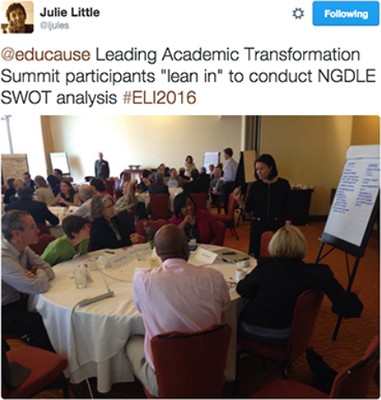
Senior leaders in teaching and learning continually face challenging issues from a variety of areas, from IT and instructional design to teaching methodologies and ever-evolving fields of expertise. Institutions of higher education are complex entities with many, many moving parts — and they must serve a very diverse set of stakeholders. Add to this the fact that those stakeholders' needs are constantly evolving, and you've got a wicked set of problems.
One example: Institutions face budget cuts, which in turn leads to increasing pressure to generate revenue; students (and often, their families) are rightfully concerned about securing a solid ROI and preparation for entering the workforce. In the midst of all of this, institutions must continue to produce programs of a high academic quality and embrace new disciplines in order to remain relevant.
The landscape seems to be shifting underfoot. But there's hope.
Great group conversation w/@michaelcrow abt leading academic transformation in #highered at #ELI2016 pic.twitter.com/8jCECqF3mP
— Bridget Burns (@BBurnsEDU) February 2, 2016
Michael Crow, President of Arizona State University and author of Designing the New American University, spoke at the Leading Academic Transformation summit.
Hearing conversations about these challenges from constituents on both sides of academia — those in teaching and learning, and those involved in technology — led EDUCAUSE Learning Initiative leadership to develop an initiative that would bridge such gaps. Leading Academic Transformation was designed to engage senior leaders, in an effort to elicit a robust dialogue that would benefit all who grapple with big picture questions in higher education.
We need to work across organizations, in concert, to present a unified support profile to the community. That's one of reasons we've established our Leading Academic Transformation program: support for teaching and learning is a cohort "affair," which requires unique leadership skills.
—Malcolm Brown
7 Things to Know About Leading Academic Transformation
A summit was convened this week at the 2016 EDUCAUSE Learning Initiative Annual Meeting to launch the face-to-face component of the initiative.
Questions posed at the summit took a hard look at strategic planning, while also looking inward at how the initiative itself might best serve its stakeholders.
- What directions should I set for future learning environments for my campus?
- How can I measure my institution's progress toward its strategic teaching and learning goals?
- What kind of community of practice would best support me and other key stakeholders in our institution's teaching and learning mission?
Participants discussed the recent EDUCAUSE white paper on the Next Generation Digital Learning Environment, which speaks to the 'future of the LMS' and how technology should evolve in order to best serve student and faculty needs on next generation digital learning environment, as well as the EDUCAUSE Benchmarking Service's maturity indices relevant to teaching and learning.
This is a winding road and one without definitive signposts, but one thing is for certain: it's imperative that institutions find ways to adequately support teaching and learning while staying abreast of technological changes. These approaches must work for not one group, but all the players involved across campus.
Kristi DePaul is marketing manager, EDUCAUSE Learning Initiative (ELI) and Next Generation Learning Challenges (NGLC), at EDUCAUSE.
